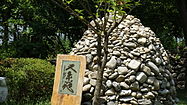geo.wikisort.org - Island
Namiseom or Nami Island (Korean: 남이섬) is a half-moon shaped river island located in Chuncheon, Gangwon Province, South Korea, formed as the land around it was inundated by the rising water of the North Han River as the result of the construction of Cheongpyeong Dam in 1944.[1]
 The view of trees in Nami Island | |
 Namiseom Location of Namiseom in South Korea | |
| Geography | |
| Location | Cheongpyeong Lake, Gangwon Province |
| Coordinates | 37°47′30″N 127°31′3″E |
Etymology
The name of the island originates from General Nami, who died at the age of 28 after being falsely accused of treason during the reign of King Sejo, the seventh king of the Joseon Dynasty of Korea.[2] Although his grave was not discovered, there were a pile of stones where his body was supposed to be buried. It was believed that if someone took even one stone from there, it would bring misfortune to their house. A tour company arranged the grave with soil and then developed Namiseom into an amusement park.[3]
Geography
Namiseom is located 3.8 km from Gapyeong County, but belongs to Chuncheon in Gangwon Province. It is 430,000 square meters in area and approximately 4 km in diameter.[4]
Gallery
References
| Wikimedia Commons has media related to Namiseom. |
- "Namiseom Island (남이섬)". english.visitkorea.or.kr. Retrieved 13 February 2020.
- "Namiseom Island FAQ". namisum.com. Retrieved 13 February 2020.
- "춘천 남이섬" [Namiseom]. terms.naver.com (in Korean). Retrieved 24 May 2019.
- "Namiseom". korea4expats.com. Retrieved 13 February 2020.
На других языках
- [en] Namiseom
[fr] Namiseom
Namiseom (aussi Namisum) est une petite île en forme de demi-lune située à Chuncheon, en Corée du Sud.[it] Namiseom
Namiseom è una piccola isola a forma di mezzaluna che si trova a Chuncheon in Corea del Sud. Si è formata dall'inondazione dovuta all'innalzamento delle acque del fiume Han a nord, risultato della costruzione della diga Cheongpyeong (청평댐) nel 1944. Il nome proviene dal generale Nami (남이장군),[1] che morì a 28 anni dopo essere stato accusato falsamente di tradimento durante il regno di Sejo, settimo re della dinastia Joseon. Sebbene il suo corpo non fu mai scoperto ci sono diverse pile di pietre dove si suppone il suo corpo sia stato sepolto. Si credeva che chiunque toccasse una di quelle pietre avrebbe portato sfortuna nella sua casa.Другой контент может иметь иную лицензию. Перед использованием материалов сайта WikiSort.org внимательно изучите правила лицензирования конкретных элементов наполнения сайта.
WikiSort.org - проект по пересортировке и дополнению контента Википедии




